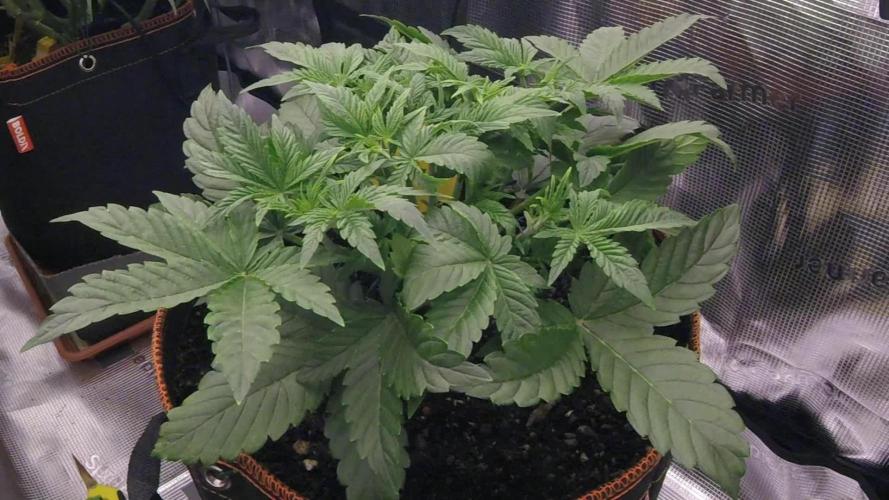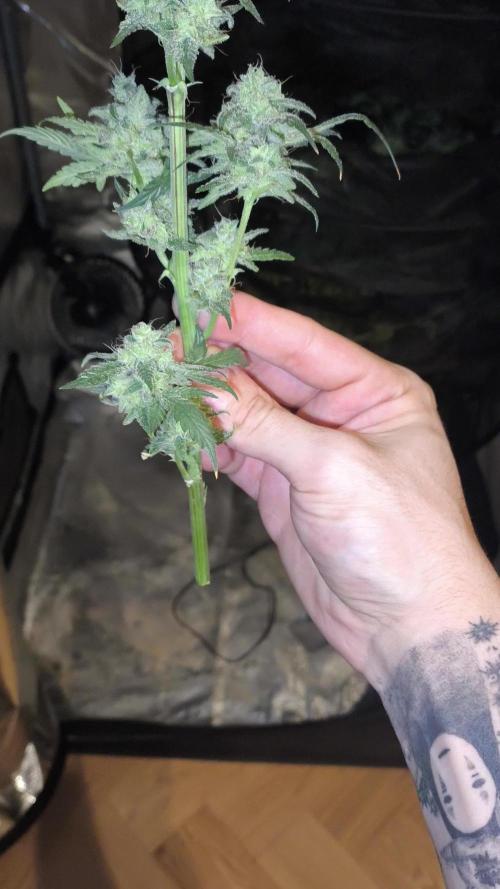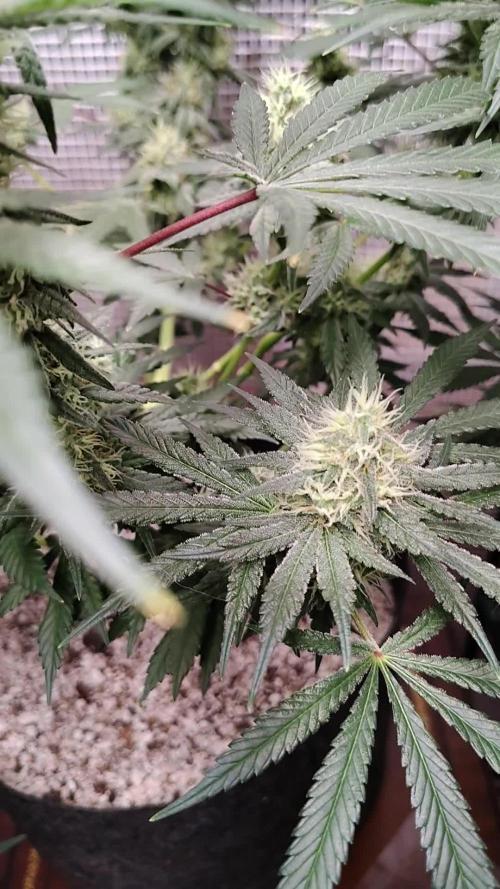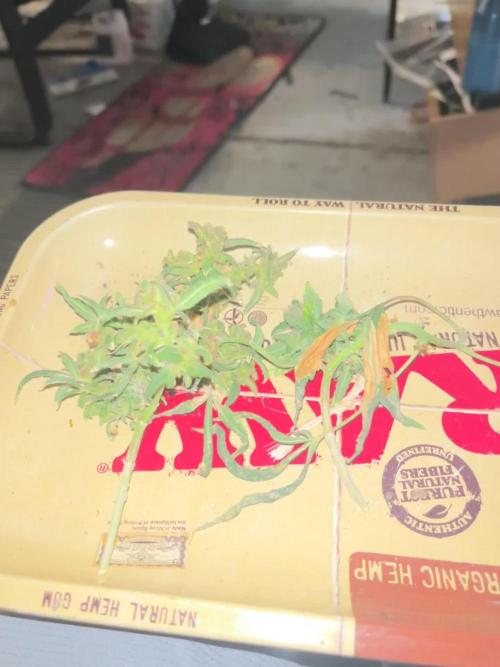The Grow Awards 2026 🏆 































Likes
Comments
Share


@Kushizlez
Follow
Day 54-64 (June 14th-24th)
(Day 55) I got a good look at all of the plants in the dark and all of them are quite faded out except for black garlic and the blueberries. Running multiple different strains that all feed differently would be a nightmare on a larger scale!
(Day 56) Everything is looking on point and happy. Plants are drinking about a liter of water every 36 hours.
(Day 59) Jack Herer #1 has some of the most wild looking foxtails I’ve ever seen. Not a very desirable trait but it’s cool to grow. It’s smell is pure bliss, it’s now matured to a mango funk. I will do a more in depth look at each strain after dry.
Jack #2 is starting to pop fresh nanners. I think it is from stress due to lack of nutrients and/or heat stress from where it is in the tent. Both jacks are feeding really hard I’ve noticed. If these bananas get any worse I will just harvest early.
Blueberry #1 is developing miniature seeds in its calyx’s and is starting to foxtail like crazy. It almost looks like it’s reveging. Earlier in the season I pulled off an entire bud that was covered in developing seeds but I couldn’t find anymore after that. I will likely find a few bag seeds in this pheno and Jack #2.
Blueberry #2 is still terpless and frostless but it’s really starting to fill into it’s structure now. It’s getting impressively dense but that all it has going for it. This one needs to go 65-70 days at least.
BAOGC #1 is so beefed up and chunky I love it. The main cola will be a good 6 grams and the lowers are thick gram nugs too. I will let this one go until day 65
BAOGC #2 is much smaller but a super hard feeder. It was one of the first to start yellowing. This pheno is pretty average in my opinion. It stacks a little tighter but has small buds
TWOG #1 has this strange velvety look to it’s frost, something I’ve never really seen before. Although it’s a little on the leafy side. It filled out super early and is ready to harvest now. Both are fading out with black streaks on the leaves.
TWOG #2 checks every box for quality so far. This might be the perfect strain and I’m sad I didn’t get a clone of it. The only thing wrong with it is the long trichome stalks and lack of resin heads. It is also an early finisher. I will probably take both TWOGs down on the 21st.
Black garlic is just mouthwatering. This plant literally looks wet with resin. It was super airy at first but slowly filled out to the point it’s one of the denser plants in the tent. Cant wait to smoke this stuff.
(Day 63) Well, every plant in here is looking done except the jacks and blueberry #2. Since I’m harvesting my other tent tomorrow I might as well give everything the chop before I risk bagseeds. I’m going to give a final watering right now and harvest tomorrow. I’m going to be drying in my flower tent kept between 60-65F and 60-65% RH. I will do a full plant hang to extend the dry time for as long as possible.
Guess that’s a wrap then. I will give a detailed breakdown of my errors and final thoughts on the run next week after the dry is completely done. ✌️
Likes
3
Share


@hinterhofgrower
Follow
.
🌱 :
💧 : 2l day 29, 1l runoff, 2l day 32
💡 : Dli: 40 mol/m²/d
🤔 :
Likes
4
Share


@DrewbieDoobieNoobie
Follow
Well I accomplished what i had set out to do, I have a IBL "In bread line " S1 feminized pile of seeds and a little bit of feminized pollen to chuck around and make a Frankenstein strain of my own. I really have to start my grows earlier to beat the heat in SoCal at the end it was to hot in the tent I wanted to go an extra week for the seeds to mature but I have more than enough ripe ones. this grow was more of an experiment that a controlled by the numbers operation. but I'm happy I got what I was looking for. cheers GD community
Addendum so after a few weeks and more deseeding I took the 150g of popcorn buds and all the shake from the seeded buds about another 150g and made some bubble hash. I used the T check meter and this is on average 10% THCa considering the plant spent most of its energy and resources making seeds I am not surprised by its low THC level. I will hang on to the beans for now and the next round will be some AUTO's maybe at the first of the year when its cooler. total hash in grams 30g the math seems to work out on the return of 300g 10% is 30g there were 2 hash balls no pictured weighing 6g total. 25micron 73 and 120 might press the 120 and the 25 gonna save the 73 for special occasions. be safe all until next time.
Likes
21
Share


@NSABND
Follow
Today start of week 13 and it´s the final coutdown to get some nice buds to harvest 😵😲😩🙏
I think tomorrow evening i harvest the plant wish me luck to get some good stuff 🙏🙏🙏🙏
Likes
1
Share


@Foxbud420
Follow
First watering without nutrients.
The cold temps are bad. The buds are small, could be more.
But im happy no mold or fungi.
Likes
10
Share


@Chubbs
Follow
420Fastbuds-Week 6
Cinderella Auto
What up grow fam. Weekly update on these 2 beautiful 😍 ladies. They got moved over to the flower tent this week. Temperatures have gone up tremendously since it seems summer weather has finally got here. Over all they seem to be handling it, OK. I'll most likely do a defoliation this week thinning it out to allow more air flow. All in all Happy Growing
Likes
5
Share


@cwgrows
Follow
Mass cloning! Not sure how many are going in the greenhouse yet but I will just give away any I don't use.
Likes
27
Share


@Jungle_James_Grows
Follow
Chopped tonight so not weighed them yet will do tomorrow if I can.
Ended up with 290g for 5 plants
But 5 same seeds and 5 different pheno's.
Judging by the looks the heaviest weight is from the one I topped .
Already weighed one plant got 28g dry weight. Got 4 more babies chopped tonight
Likes
3
Share


@Liquido
Follow
Questa è la prima GMO che raccolgo, cime molto più dense rispetto alla runtz e sembra essere molto più pesante, tra qualche giorno raccoglierò l'altra e poi mancano solo le due più grandi
Likes
94
Share


@Master_weeda
Follow
Hello to all padawans and Jedi masters
What a week! The last 2 plants of this magnificent diarie are simply sumptuous 😉
A treat for the eyes and for the olfactory system!
Nothing to say about the techniques used this week because I do nothing more than water them. 😊
Blueberry attacks senescance her trichomes are amber to the tune of 10% I think I'll harvest it this week
Bubblegum is in full bloom
I expect a very big yield For an autoflowering
See you soon
Bonjour à tous les padawans et maîtres jedis
Quelle semaine ! Les 2 derniers plants de ce magnifique diarie sont tout simplement somptueux 😉
Un régal pour les yeux et pour le système olfactif !
Rien à dire sur les techniques employés durant cette semaine car je ne fais rien de plus que les arroser. 😊
La blueberry attaque la senescance ses trichomes sont ambrés à hauteur de 10% je pense la récolter cette semaine
La bubblegum est en pleine floraison
Je m'attends à un très gros rendement Pour une autofloraison
À bientôt
Likes
10
Share


@MadeInGermany
Follow
Flowering day 7
since time change
to 12/12 h.
Hey guys :-)
The flowering started last week because otherwise the space in the small tent would end up being too narrow :-)
Cuttings were taken from each phenotype beforehand.
To change the flower, I rinsed it very lightly with clean fruits.
With the next watering she gets a mix of grow liquid and bloom liquid before she only gets bloom.
The heating mat works perfectly in the small tent and the parameters are all in the optimal range 🙏🏻👍.
Now we hope that everything stays that way and that the cold days will slowly pass :-) .
Everything was cleaned and checked.
have fun and stay healthy 🙏🏻
👇🏼👇🏼👇🏼👇🏼👇🏼👇🏼👇🏼👇🏼👇🏼👇🏼👇🏼👇🏼
You can buy this Nutrients at :
https://greenbuzzliquids.com/en/shop/
With the discount code: Made_in_Germany you get a discount of 15% on all products from an order value of 100 euros.
👇🏼👇🏼👇🏼👇🏼👇🏼👇🏼👇🏼👇🏼👇🏼👇🏼👇🏼👇🏼
You can buy this strain at :
https://www.exoticseed.eu/
Water 💧 💧💧
Osmosis water mixed with normal water (24 hours stale that the chlorine evaporates) to 0.2 EC. Add Cal / Mag to 0.4 Ec Ph with Organic Ph - to 5.8 - 6.5
MadeInGermany
Likes
21
Share


@Scottydarkmoonbuds
Follow
WOW, she smells SOOO GOOD! A big thanks to @hindugod what a great strain! She is, of course, in the lead in the flowering phase.
Likes
31
Share


@420DeepGrow
Follow
Gracias al equipo de AnesiaSeeds, Marshydro, XpertNutrients y Trolmaster sin ellos esto no sería posible.
💐🤯 39%Thc Wham Boom:
Sube al ring con WHAM BOOM de Anesia Seeds, donde la energía electrizante de Wham choca con las vibraciones frías de RS54, creando una variedad que es todo equilibrio, potencia y sabor. Este peso pesado feminizado ofrece una mezcla perfecta de 50% Sativa y 50% Indica, proporcionando una experiencia que te hará flotar de euforia mientras tu cuerpo se sumerge en una serena relajación.
WHAM BOOM es una productora prolífica, con rendimientos en interior de 600g/m² y en exterior que alcanzan la asombrosa cifra de 900 - 1200g por planta. Con una floración de entre 65 y 70 días, esta variedad está lista a principios de octubre, lo que la convierte en una competidora ideal para los cultivadores que aspiran a una cosecha de campeonato. Con una imponente presencia de 100-140 cm en interior y 160-220 cm en exterior, WHAM BOOM se alza como testimonio de su destreza genética.
🏠 : Marshydro 1.50 x 1.50 x 1.80, carpa 100% estanca con ventanas laterales para llegar a todos los lugares durante el grow
https://marshydro.eu/products/diy-150x150x200cm-grow-tent-kit
🌬️💨 Marshydro 6inch + filtro carbon para evitar olores indeseables.
https://marshydro.eu/products/ifresh-smart-6inch-filter-kits/
💻 Trolmaster Tent-X TCS-1 como controlador de luz, optimiza tu cultivo con la última tecnología del mercado, desde donde puedes controlar todos los parametros.
https://www.trolmaster.com/Products/Details/TCS-1
🍣🍦🌴 Xpert Nutrients es una empresa especializada en la producción y comercialización de fertilizantes líquidos y tierras, que garantizan excelentes cosechas y un crecimiento activo para sus plantas durante todas las fases de cultivo.
Consigue aqui tus Nutrientes:
https://xpertnutrients.com/es/shop/
📆 Semana 4:
Aparecieron un monton de erizos esta semana, el temporal ha hecho algo de mella en la carpa al bajar las temperaturas aunque todo sigue correcto.
Continuamos con las dosis de nutrientes recomendadas por el fabricante.
Likes
1
Share


@Nikkov
Follow
What's up guys
Well, another week has passed and the heat here in my city has increased a lot and as I don't have air conditioning the grow room has been very hot, the humidifier has helped but not enough and we'll see what happens from now on. =D
Likes
12
Share


@Staffedition
Follow
Привет друзья. Моей растихе сегодня 176 дней
27.12 перестал кормить и начал проливать чистой водой
20.10 перевёл свет в режим 12/12
Начал применять LST технику на 19 дне, а 18 августа добавил ДЕФОЛИЗАЦИЮ
С 20.08 ДЕФОЛИЗАЦИЮ
С 20.08 LST технику
На сегодняшний день влажность 54%
5.09.2023 заметил высокий Ph 7.9
С 48 дня Ph не ниже 5.8
На сегодняшний день Ph 6.0
Начал кормить с 60 дня Canna Terra Vega
PPM 150
Всем мира и добра!
Не забудь поставить лайк❤️, если понравилась как прошла неделя
И читайте наш TELEGRAM: https://t.me/smail_seeds
#Smail_Seeds 😀
Likes
31
Share


@Dunk_Junk
Follow
She grew 13cm this week. Not bad. She's looking good. Tent is a little bit too overcrowded for her at the moment but in a few days the situation will be better.




























